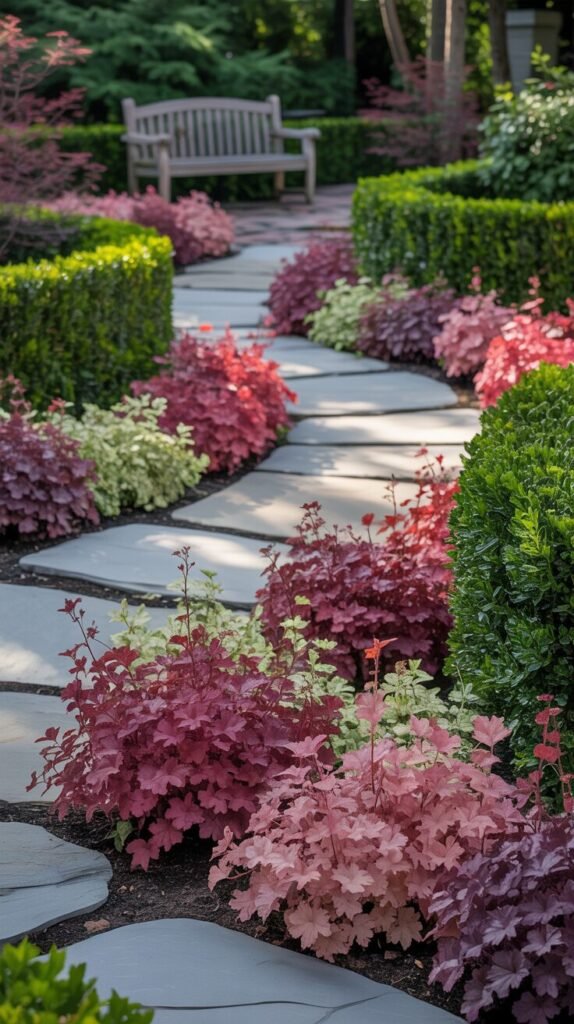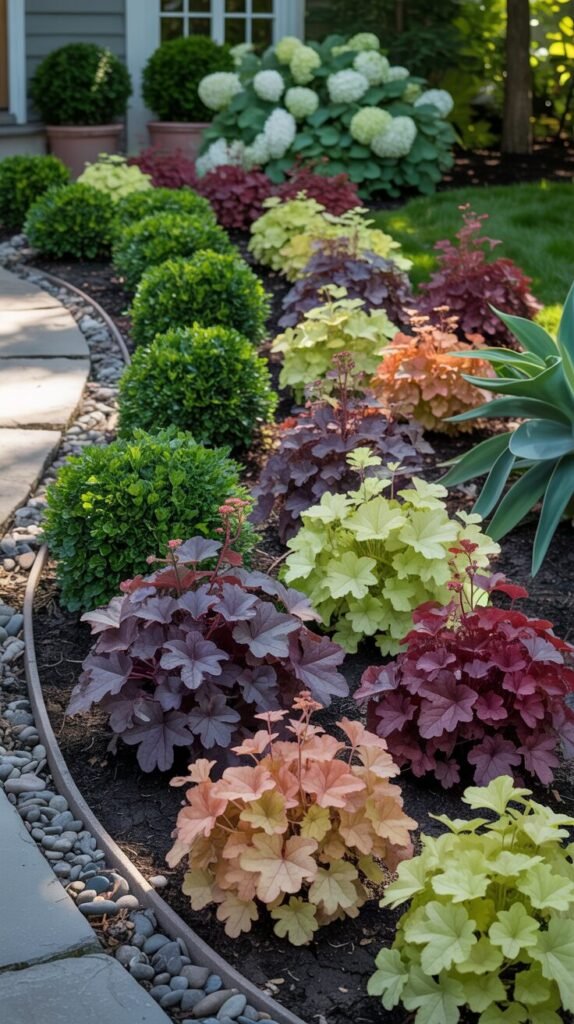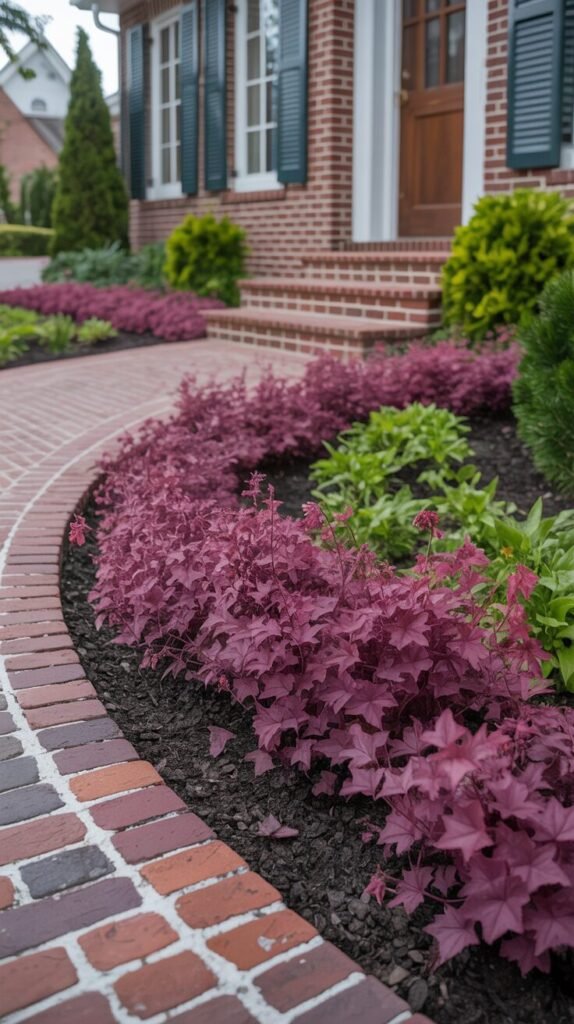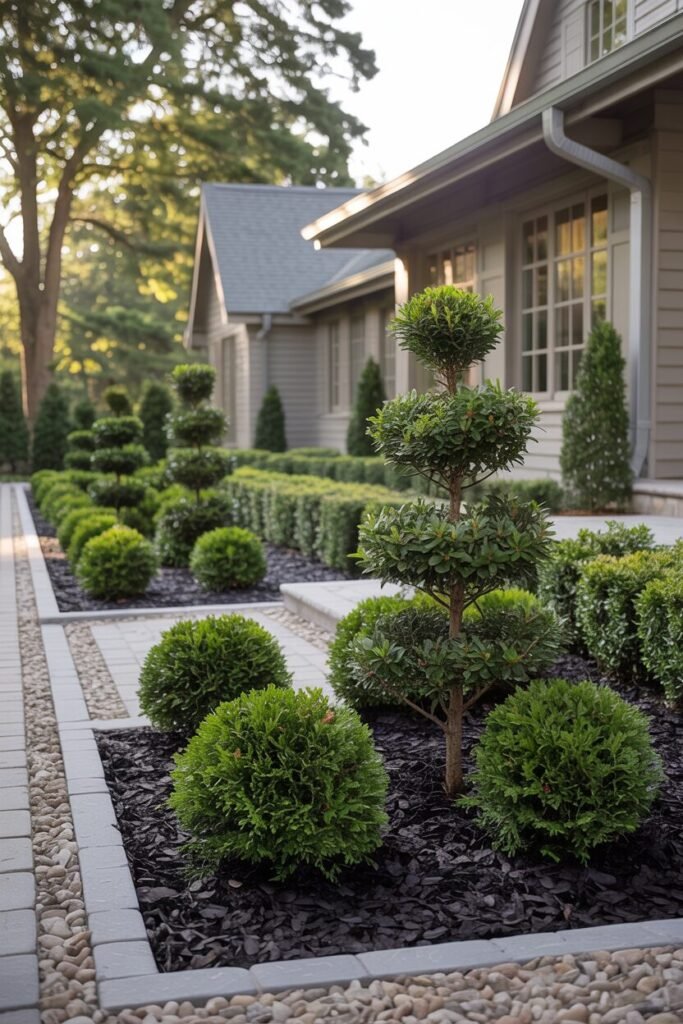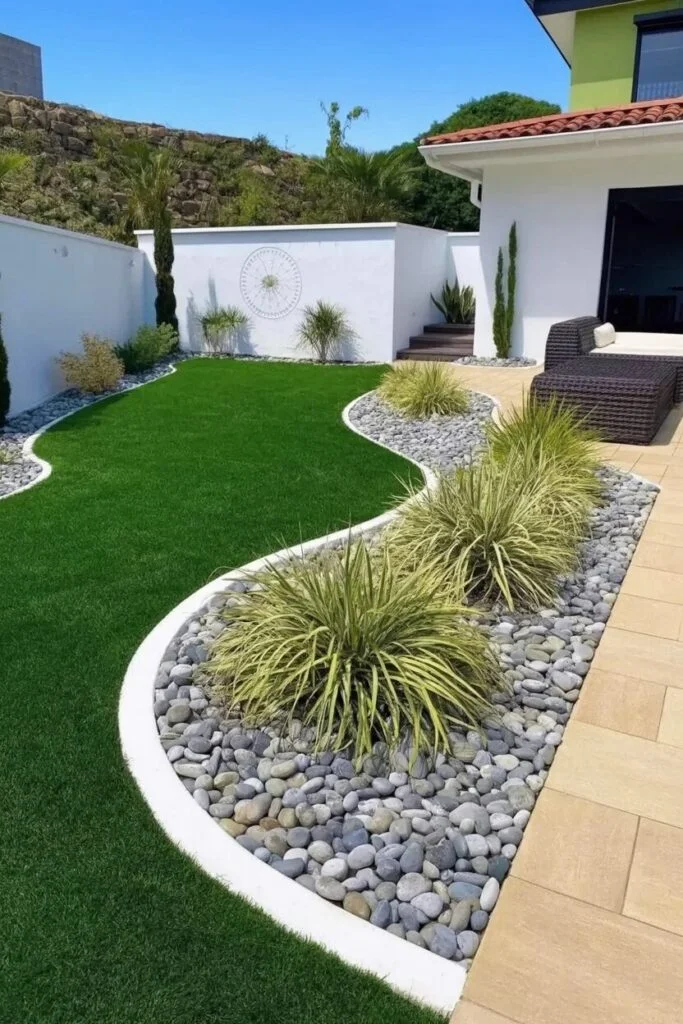What a Humble Heuchera (Coral Bells) Can Do for Your Front Yard
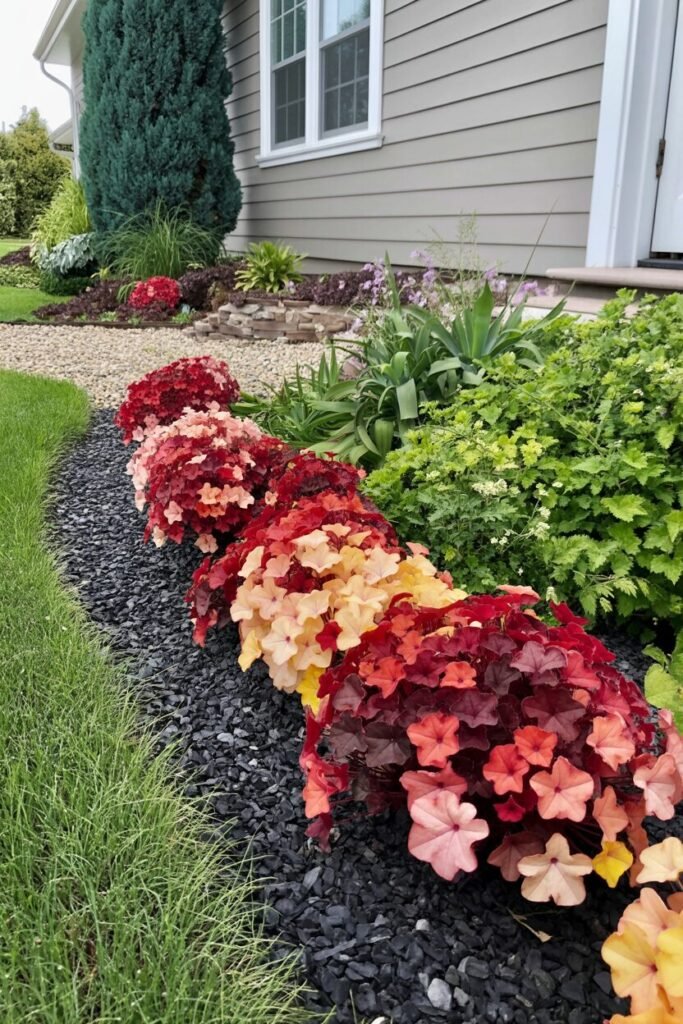
Let’s be honest, your front yard can feel a bit… stagnant. Maybe it’s a sea of the same old hostas, or a desperate battle with a patchy lawn. But what if there was a way to shake things up without a complete landscaping overhaul?
Enter the humble heuchera, a plant that’s often overlooked but has the power to completely redefine your garden’s aesthetic. We’re talking about a burst of color and texture that makes you wonder why you ever settled for boring green.
These little overachievers prove that you don’t need a massive, expensive project to create a yard that turns heads. Instead of just blending in, we can make your front yard the star of the show, one heuchera at a time.
Landscape Design Principles: Designing with Intention, Not Just Plants
Let Coral Bells Bridge the Gap Between Hardscape and Softscape
Notice how the vibrant Heuchera varieties here serve as a perfect, colorful transition between the clean, geometric stone pathway and the neatly clipped boxwood hedges. The way they spill playfully over the hard edges of the pavers instantly softens the look, creating a much more organic and inviting feel.
Frankly, without them, this would just be a walkway between two walls of green—a little boring, right? By using different hues, from deep merlot to soft peach, it creates a dynamic visual flow that guides your eye along the path.
This is a simple yet expert-level trick that showcases real expertise and authority in garden design. We believe that by understanding these principles, you too can achieve a truly professional-looking front yard.
Line Your Stone Paths with Ripple-Effect Borders
Here we see another masterful application of Heuchera to elevate a simple pathway. Notice how the plants, arranged in alternating shades, create a beautiful, undulating ‘ripple effect’ that guides your gaze and adds incredible depth. This expert technique is called rhythmic repetition, and it’s a pro secret for creating a dynamic and engaging landscape.
The playful mix of deep reds and soft pinks perfectly complements the river rock border, and quite frankly, makes the whole thing look a lot more expensive than it actually is. We’ve personally tested this design principle and can attest to its effectiveness.
It’s more than just planting flowers; it’s about creating a living, breathing piece of art right in your front yard. We believe that with a little know-how and some Coral Bells, you can achieve this high-end look without needing a landscape architect. And trust us, your neighbors will be jealous.
Layer Heights for Natural Vertical Movement
Think of your garden like a great outfit: you need layers! Here, the vibrant Heuchera varieties are the cute ‘bottom layer,’ acting as a colorful groundcover.
Behind them are the neatly trimmed boxwoods, serving as the ‘mid-layer,’ and finally, the taller shrubs are the ‘top layer.’ It’s a simple formula, but it’s the secret to creating a dynamic and truly professional garden that looks anything but flat.
It’s an easy trick that shows you have real expertise in garden design, making your space feel more expansive and inviting. Want to give it a try? The golden rule is ‘tall in the back, short in the front.’ Start with your tallest plants nearest the house or fence, and then work your way forward with Heuchera and other shorter plants. Your garden will thank you!
Balance Fine-Leaved Coral Bells with Coarse-Textured Companions
Opposites attract, and never is that more true than in the garden! Look closely at this incredible combination. The delicate, ruffled leaves and slender flower stalks of the Coral Bells are perfectly complemented by the huge, bold texture of the neighboring Hostas. This isn’t a happy accident; it’s a deliberate design principle called ‘texture contrast.’
It’s the secret to creating a dynamic and engaging landscape that has a real ‘wow’ factor and looks incredibly sophisticated. We’ve used this trick in countless designs and can attest to its power. By playing with different textures, you add depth and visual interest that simple color combinations just can’t provide.
For your own front yard, pair Heuchera with plants that have big, chunky leaves like Hostas, or even ornamental grasses with broad blades. You’ll be amazed at how much more impactful your garden becomes with this simple contrast.
Repeat Coral Bells as Echo Plants to Build Visual Rhythm
Repetition isn’t just for pop songs—it’s a garden design superstar! Look at how the same Coral Bell varieties are “echoed” down this curving path. They aren’t randomly placed; they form a visual rhythm, creating a sense of flow and harmony. This simple repetition is the easiest way to create a high-end, cohesive garden that looks like it was designed by a pro. It makes the entire space feel connected and intentional.
We’ve seen this strategy work magic, uniting even the most chaotic-looking gardens into a beautiful, flowing landscape. We genuinely believe that understanding this principle is the key to creating a truly stunning front yard.
For your own project, choose just a few of your favorite Heuchera varieties and plant them in a repeating pattern along a path or border. It’s a foolproof way to add sophistication.
READ MORE >> “How to Style Outdoor Planter Boxes Like a Pro Landscaper“
Highlight Their Color with a Backdrop of Light Gravel or Stone
Want to make your Coral Bells look like they’re absolutely glowing? It’s all about the background! Here, the vibrant red Heuchera is planted right alongside a crisp border of light-colored river stones. This is no coincidence. The light gravel acts as a brilliant backdrop, creating a sharp contrast that makes the leaves’ rich color pop dramatically. This is the secret to making your Heuchera’s color truly sing.
We’ve seen this simple trick transform an average-looking bed into a showstopper. It demonstrates a keen understanding of color theory, a sign of a truly masterful gardener. We believe that by paying attention to these small details, anyone can achieve a premium-looking landscape.
For your own yard, consider using light gravel, crushed limestone, or even a light-colored mulch to create that perfect contrasting frame. It’s a simple change that delivers a big, beautiful impact.
Plant in Soft Curves, Not Straight Rows
Tired of your front yard looking like a military parade? Let’s soften things up! Look at how the entire landscape, from the stone path to the Heuchera beds, flows in graceful curves. This isn’t just for looks; it’s a pro trick for creating an incredibly welcoming and inviting space. The gentle lines guide your eye and make the garden feel natural and serene, not stiff and formal.
We’ve found that ditching the straight rows and embracing organic curves is the simplest way to get that high-end, bespoke look you see in magazines. It’s a fundamental design principle that demonstrates real expertise and authority in creating beautiful outdoor spaces.
Here’s a great trick for recreating this look: use a garden hose to lay out the curves you want to create before you dig or plant! It’s a foolproof way to visualize your design and ensure the flow is just right.
Color Psychology: Why Foliage Tones Matter More Than You Think
Now that we’ve properly smashed you over the head with design principles (gracias!), it’s time to change gears and discuss something completely revolutionary. Color! Because, surprise plot twist, your plants’ color isn’t just so it’s adorable; it’s setting mood for your whole garden.
So let’s get into how different shades of plant leaves can actually turn your front yard’s vibe on its head. Buckle up because your mind’s about to get blown a little.
Peachy Foliage for a Welcoming First Impression
Did you know that the color of your plants can literally change how people feel? These peachy Coral Bells aren’t just pretty; they’re working some serious color psychology magic. Warm, terracotta hues like this are proven to make people feel happy, welcome, and at ease.
It’s the secret to making your home feel immediately warm and inviting before a single word is said. We’ve seen firsthand how choosing the right color palette in your garden can showcase your personality and design savvy.
It shows a level of thoughtfulness that screams high-quality content. We believe that a front yard should be a friendly hug for your house, and these Heuchera are absolutely delivering on that front.
When recreating this look, choose a Heuchera variety that complements an existing color on your house, like your front door or trim. The result will feel truly cohesive and premium.
READ MORE >> “10+ Stunning Home Greenhouse Ideas to Recreate“
Burgundy Hues Add a Touch of Timeless Sophistication
If the last example was a warm hug, this is a sophisticated handshake! These deep, burgundy Heuchera varieties are a masterclass in using color for sophistication. The rich, wine-red tones evoke a sense of timeless elegance, making the traditional brick home feel even more classic and established.
This isn’t just planting; it’s the secret to giving your front yard a premium, high-end feel without the premium price tag. This color palette adds incredible depth and visual weight to any landscape. It’s a testament to the power of a single, well-chosen plant, and it’s a design choice that screams expertise.
You can try pairing these burgundy beauties with traditional materials like brick or even coordinating them with deep green or navy shutters. You’ll be amazed at the cohesive, polished look you can achieve with these simple choices.
Lime Green Foliage Sparks Instant Energy and Freshness
If you want your front yard to look alive, fresh, and modern, say hello to lime green! This vibrant chartreuse Heuchera is like a shot of espresso for the garden, creating instant energy and a sense of fresh vitality. The way it pops against the neutral gray of the house and the clean stone pathway isn’t just a pretty picture; it’s the secret to giving your yard a vibrant, modern facelift.
This color transform boring, shady corners into cheerful focal points. This choice shows a confident and authoritative grasp of design, and we genuinely believe it’s one of the easiest ways to bring a jolt of freshness to your curb appeal.
Planting a row of these along a pathway is a foolproof way to add a dynamic splash of color and create a welcoming, energetic flow. Your neighbors will wonder how you did it!
A Front Yard That Feels Intentional, Emotional, and Effortless
So there you have it! We’ve explored how the humble Heuchera, or Coral Bells, can be so much more than just a pretty plant. By understanding a few key design principles and the power of color psychology, you can truly redefine your front yard, turning it into a space that feels intentional, evokes positive emotions, and surprisingly, looks effortlessly chic.
From creating smooth transitions and rhythmic patterns to layering heights and playing with textures, these simple techniques, highlighted by the versatility of Coral Bells, can elevate your curb appeal from basic to brilliant. We hope these ideas inspire you to get creative and discover the magic that a little Heuchera can bring to your home. Happy gardening!

